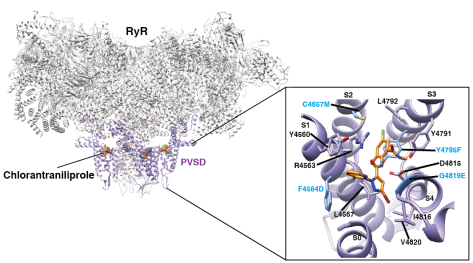Diamide insecticides, developed by pesticide giants DuPont, Bayer and Syngenta, are among the most popular insecticides on the market, with annual sales >USD$2 billion. Diamide insecticides are considered safe for mammals and nontargeted beneficial insects, and are thus widely used to protect many types of crops, including vegetables, fruits and cottons. However, due to heavy usage, many pests have developed strong resistance, posing a threat on food safety in many countries. Therefore, there is an urgent need to understand the underlying mechanisms of diamide modulation and resistance mutations, based on which novel green insecticides could be developed in a rational way.

New findings from the research team led by Prof. Zhiguang Yuchi from School of Pharmaceutical Science and Technology (SPST) at Tianjin University working with the colleagues in Canada, Japan, Germany, and the Netherland, published today in Nature Chemical Biology, reveal the binding mode of diamide insecticide in targeted ryanodine receptor (RyR) for the first time and answer many fundamental questions about the species selectivity and resistance mechanism.
In this study, the team successfully solved the cryo-electron microscopy (EM) structure of chlorantraniliprole, the best-selling diamide insecticide, in complex with RyR at 3.8 Å resolution. Chlorantraniliprole is located in the pseudo-voltage-sensor domain (PVSD) of RyR. The molecule induces a conformational change by affecting the S4-S5 linker, triggering channel opening, which causes the uncontrolled release of calcium ions from endoplasmic reticulum store, contraction paralysis, and ultimately the death of treated larvae. Interestingly, the four known resistance mutations are all located near the insecticide binding pocket, but cause resistance via two mechanisms, either by mutating key residues involved in binding or by introducing steric hindrance. The binding site is further corroborated with data from cellular, Drosophila, and in silico mutagenesis studies, which reveal how diamide insecticides are selective to the Lepidoptera group of insects over honeybee or mammalian RyRs. Through modeling and mutagenesis study, the researchers also revealed the binding mode of phthalic diamide, flubendiamide, which differs from the anthranilic diamide chlorantraniliprole.
Over 500 mutations identified in RyR genes are associated with genetic myopathies, such as malignant hyperthermia, central core disease and catecholaminergic polymorphic ventricular tachycardia. The researchers verified the activities of diamides against the mutant mammalian RyRs, based on which they proposed to develop therapeutic molecules targeting the allosteric diamide-binding site with the aim to treat muscle diseases and heart diseases.

These findings provide a foundation for developing novel pesticides to overcome the resistance crisis, and to decrease toxicity for humans and beneficial insects. It also highlights an allosteric site that can be targeted for novel therapeutics in humans.
Paper link:
DOI: 10.1038/s41589-020-0627-5

